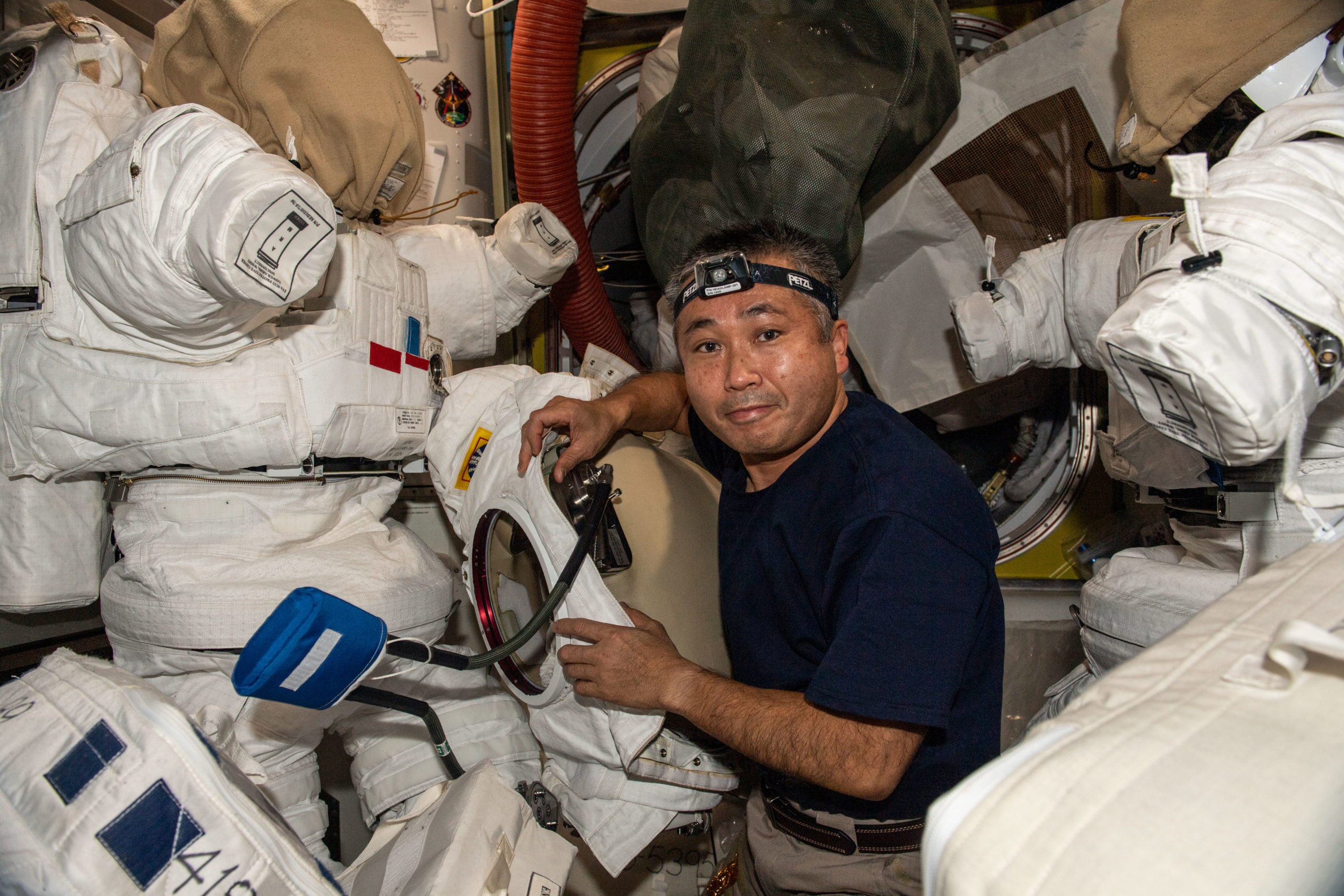
First-time spacewalkers Josh Cassada and Frank Rubio have resumed work to outfit the International Space Station (ISS) with a total of six new solar arrays. When fully assembled and integrated, the Boeing-built ISS Roll-Out Solar Arrays (iROSAs) will cover and “shadow” six of the eight legacy Solar Array Wings (SAWs), affording a “hike” of electrical power output of 20-30 percent for the sprawling multi-national outpost.
Cassada and Rubio worked for seven hours and 11 minutes to install a mounting bracket—called a “modification kit”—on Power Channel 1B at the base of the starboard-side S-6 truss. That will set the stage for the arrival of the iROSA array for that power channel, early next spring.

As previously reported by AmericaSpace, three pairs of iROSAs will support future ISS expansion and customers’ burgeoning payload needs. This will serve to increase the station’s overall electrical power output from 160 kilowatts to 215 kilowatts.
Original plans identified six power channels—2B and 4B on the station’s P-6 truss, 4A on the P-4 truss, 1A and 3A on the S-4 truss and 3B on the S-6 truss—which would derive greatest benefit from having iROSAs in place. Power Channels 2A on the P-4 truss and 1B on the S-6 truss were not initially earmarked for iROSA modification.

Astronauts’ attention turned firstly to P-6, the oldest energy-producing component of the Integrated Truss Structure (ITS), delivered and installed by shuttle Endeavour’s STS-97 crew more than two decades ago. In late February and early March 2021, Expedition 64 spacewalkers Kate Rubins, Victor Glover and Soichi Noguchi executed two complex sessions of Extravehicular Activity (EVA) to install a modification kit—delivered aboard Northrop Grumman Corp.’s NG-14 Cygnus cargo ship in October 2020—at the base of P-6.
Three months later, the iROSA arrays for Power Channels 2B and 4B arrived at the station aboard SpaceX’s CRS-22 Cargo Dragon and were installed onto P-6 by Expedition 65 spacewalkers Shane Kimbrough and Thomas Pesquet during a three-EVA marathon in June 2021. Another modification kit—delivered via the NG-16 Cygnus in August 2021—was installed onto the P-4 truss in September of last year by Expedition 65’s Pesquet and Aki Hoshide to support a future iROSA array at the Power Channel 4A location.

More recently, last February, yet another modification kit arrived aboard the NG-17 Cygnus and a few weeks later in mid-March Expedition 66 spacewalkers Kayla Barron and Raja Chari fitted it to the station’s S-4 truss to support the future augmentation of Power Channel 3A. But subsequent iROSA expansion—originally scheduled for last August, during the Crew-4 increment—was curtailed by several months, following a water intrusion incident experienced by German spacewalker Matthias Maurer, also last March.
The water covered nearly half of Maurer’s helmet face plate and all scheduled U.S. EVAs were correspondingly put on hold until a resolution could be found. His space suit, designated Extravehicular Mobility Unit (EMU) 3015, was returned to Earth in August aboard SpaceX’s CRS-25 Cargo Dragon for teardown and analysis.

Finally, in mid-October, NASA completed a Flight Readiness Review (FRR) and declared a “Go” status for U.S. EVAs to resume in November. It noted that water samples and suit hardware associated with EMU 3015 had also been returned to Earth aboard Soyuz MS-19 in March 2022 and Dragon Endurance at the end of the Crew-3 mission in early May.
Teams confirmed no hardware failures within EMU 3015 itself and identified the most likely cause as “integrated system performance”, in which several variables, such as crew exertion and crew cooling settings produced comparatively larger-than-normal amounts of condensation. Operational procedures were updated, alongside the development of new mitigation hardware, “to minimize scenarios where integrated performance results in water accumulation, while absorbing any water that does appear”.

Last week, another modification kit arrived at the station aboard the NG-18 Cygnus. And this latest kit was directly pertinent to today’s EVA, since it was set to be installed by Cassada and Rubio in readiness for the augmentation of Power Channel 1B on the S-6 truss.
This channel was not originally meant to be modified, but NASA recently “re-evaluated power draws” on all channels and “reallocated the installation of iROSAs”. Left unmodified under the new plan are Power Channels 2A on the P-4 truss and 3B on the S-6 truss.
Preparations for the EVA—officially designated “U.S. EVA-81”—got underway last month, when the incumbent U.S. Operational Segment (USOS) crew of Cassada, Rubio, Nicole Mann and Japan’s Koichi Wakata began gathering and setting up tools and equipment inside the station’s Quest airlock. Last week, they familiarized themselves with the modification kit installation task and participated in an EVA procedures conference with ground-based specialists.
Early Tuesday, the crew dove directly into EVA-81 tasks, with Mann and Wakata assisting Cassada and Rubio to don their space suits in Quest’s inner “equipment lock”. Here the spacewalkers performed In-Suit Light Exercise (ISLE), flexing their arms and legs, before being sealed inside the outer “crew lock”, to a hearty “Godspeed” from Mann.

The airlock’s outer hatch was pushed open by Cassada—in his capacity as EV1, the lead spacewalker, with red stripes on the legs of his suit—at 9:14 a.m. EST, an hour later than intended. Led by a Mission Control team headed by Flight Director Anthony Vareha, and including Lead Spacewalk Officer Kieth Johnson and astronaut Zena Cardman at the Capcom’s console, early Display and Control Module (DCM) difficulties were overcome and Cassada and Rubio moved briskly about their work.
With the installation of the modification kit at the Power Channel 1B location, the stage is now set for the next three sets of iROSAs to be installed. Two arrays are due to arrive next week aboard SpaceX’s CRS-26 Cargo Dragon and will outfit Power Channel 3B on the S-4 truss and Power Channel 4A on the P-4 truss during EVAs scheduled for 28 November and 1 December.






2 Comments
2 Pings & Trackbacks
Pingback:يبدو الطقس مواتياً لإطلاق CRS-26 ، تم تحديد رواد الفضاء لمهام iROSA التالية
Pingback:SpaceX Launches CRS-26 Cargo Dragon, Heads for Space Station – Space News